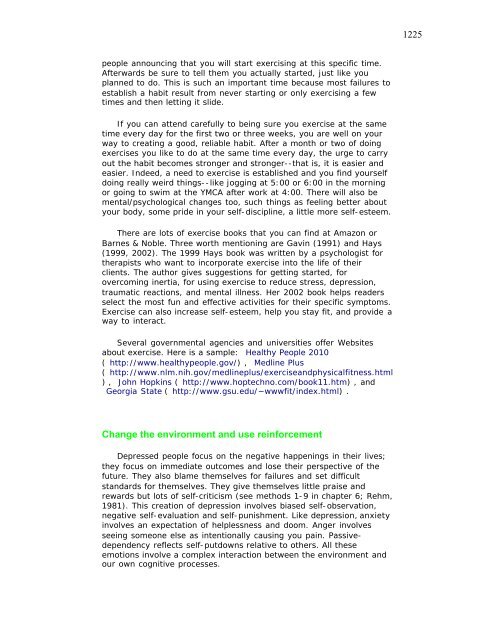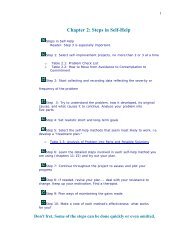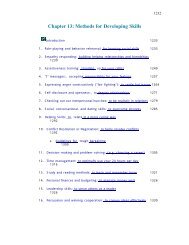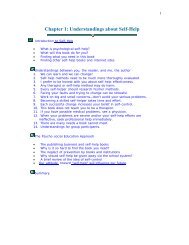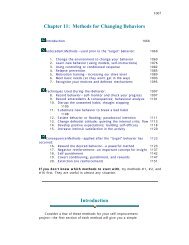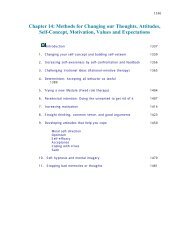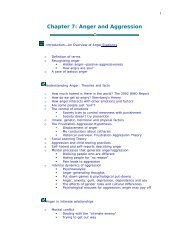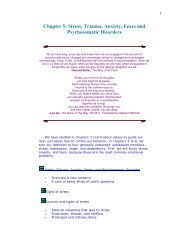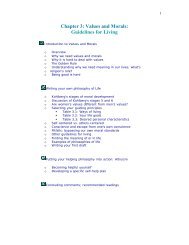Chapter 12: Methods for Changing Emotions - Psychological Self-Help
Chapter 12: Methods for Changing Emotions - Psychological Self-Help
Chapter 12: Methods for Changing Emotions - Psychological Self-Help
You also want an ePaper? Increase the reach of your titles
YUMPU automatically turns print PDFs into web optimized ePapers that Google loves.
<strong>12</strong>25<br />
people announcing that you will start exercising at this specific time.<br />
Afterwards be sure to tell them you actually started, just like you<br />
planned to do. This is such an important time because most failures to<br />
establish a habit result from never starting or only exercising a few<br />
times and then letting it slide.<br />
If you can attend carefully to being sure you exercise at the same<br />
time every day <strong>for</strong> the first two or three weeks, you are well on your<br />
way to creating a good, reliable habit. After a month or two of doing<br />
exercises you like to do at the same time every day, the urge to carry<br />
out the habit becomes stronger and stronger--that is, it is easier and<br />
easier. Indeed, a need to exercise is established and you find yourself<br />
doing really weird things--like jogging at 5:00 or 6:00 in the morning<br />
or going to swim at the YMCA after work at 4:00. There will also be<br />
mental/psychological changes too, such things as feeling better about<br />
your body, some pride in your self-discipline, a little more self-esteem.<br />
There are lots of exercise books that you can find at Amazon or<br />
Barnes & Noble. Three worth mentioning are Gavin (1991) and Hays<br />
(1999, 2002). The 1999 Hays book was written by a psychologist <strong>for</strong><br />
therapists who want to incorporate exercise into the life of their<br />
clients. The author gives suggestions <strong>for</strong> getting started, <strong>for</strong><br />
overcoming inertia, <strong>for</strong> using exercise to reduce stress, depression,<br />
traumatic reactions, and mental illness. Her 2002 book helps readers<br />
select the most fun and effective activities <strong>for</strong> their specific symptoms.<br />
Exercise can also increase self-esteem, help you stay fit, and provide a<br />
way to interact.<br />
Several governmental agencies and universities offer Websites<br />
about exercise. Here is a sample: Healthy People 2010<br />
( http://www.healthypeople.gov/) , Medline Plus<br />
( http://www.nlm.nih.gov/medlineplus/exerciseandphysicalfitness.html<br />
) , John Hopkins ( http://www.hoptechno.com/book11.htm) , and<br />
Georgia State ( http://www.gsu.edu/~wwwfit/index.html) .<br />
Change the environment and use rein<strong>for</strong>cement<br />
Depressed people focus on the negative happenings in their lives;<br />
they focus on immediate outcomes and lose their perspective of the<br />
future. They also blame themselves <strong>for</strong> failures and set difficult<br />
standards <strong>for</strong> themselves. They give themselves little praise and<br />
rewards but lots of self-criticism (see methods 1-9 in chapter 6; Rehm,<br />
1981). This creation of depression involves biased self-observation,<br />
negative self-evaluation and self-punishment. Like depression, anxiety<br />
involves an expectation of helplessness and doom. Anger involves<br />
seeing someone else as intentionally causing you pain. Passivedependency<br />
reflects self-putdowns relative to others. All these<br />
emotions involve a complex interaction between the environment and<br />
our own cognitive processes.


